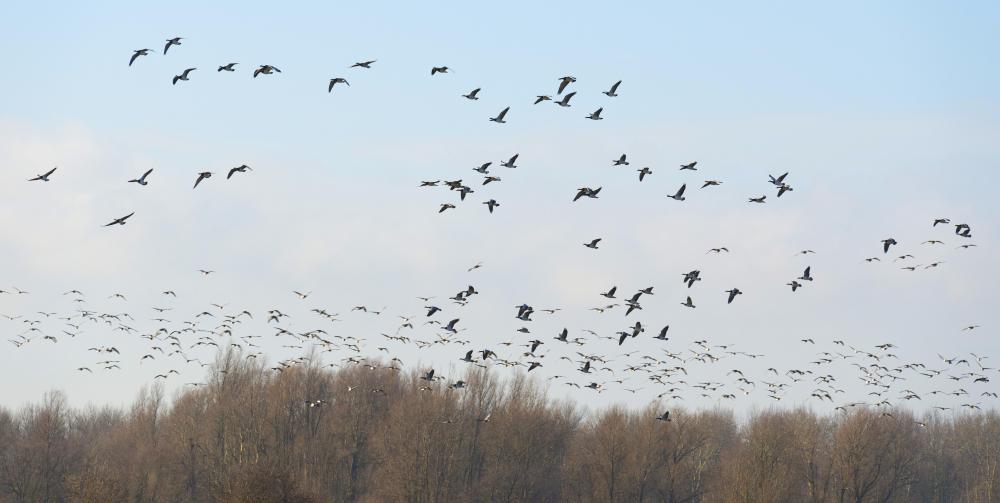At AllThingsNature, we're committed to delivering accurate, trustworthy information. Our expert-authored content is rigorously fact-checked and sourced from credible authorities. Discover how we uphold the highest standards in providing you with reliable knowledge.
What Is a Snow Goose?
The snow goose (Chen caerulescens) is a migratory bird, generally found in North America, that feeds mostly on vegetation and is known for its shrill honking call. The adult bird is about 27 to 33 inches (69 to 84 cm) in length with a wing span of up to 65 inches (165 cm) and may weigh up to 7 pounds (3.2 kg). Two subspecies of the bird exist, the lesser snow goose and the greater snow goose. Snow geese may have white or dark plumage but generally have black wing tips, black patches on the sides of their bills, and pink legs and bills.
Breeding in the Arctic, snow geese migrate south for the winter. Geese migrate to areas with warmer winter weather, including the northwest coast of the United States or the Gulf Coast of Texas and Louisiana. The fowl also spend winters along the eastern seaboard from New Jersey to North Carolina. It is common for the snow geese to migrate to the Southwestern United States and even the central highlands of Mexico. During winters, the birds inhabit marshes, bays, and grasslands.
When a snow goose is 2 years old, it finds a mate. Male and female stay paired for life. Social creatures, snow geese nest together in large colonies. Some colonies include thousands of pairs of snow geese.

Sexually mature at 2 to 3 years of age, snow geese mate around June. During mating season, snow geese are territorial, and couples defend their nest sites. A female generally lays four or five white eggs. Eggs take approximately three weeks to hatch and when born, the goslings are gray. Males and females share responsibility in raising their young and lead the young from the nest within a day of hatching.
The young are capable of feeding themselves after leaving the nest. A diet of a snow goose consists of seeds, grains, leaves, roots, grass, aquatic vegetation, and berries. Both parents stay with their young for at least the first winter and often go their separate ways after the second or third migration.
Good swimmers, snow geese do not dive to search for food, but often go under water to avoid predators, including eagles, foxes, and wolves. When on land, the birds are able to run quickly. Adept fliers, snow geese may soar at speeds of up to 50 miles (80.4 km) per hour.
Frequently Asked Questions
What is a Snow Goose?
A Snow Goose is a North American species of wildfowl belonging to the genus Anser. They are known for their white plumage and black wingtips, although some exhibit a dark color phase called "blue morph." These birds are highly migratory, traveling thousands of miles between their Arctic breeding grounds and wintering areas in warmer regions.
How can you distinguish between a Snow Goose and other geese?
Snow Geese are identifiable by their white feathers and pink bills, contrasted with black wingtips. They are also smaller than Canada Geese. The blue morph variety, which has bluish-gray plumage with a white head, can be distinguished from other geese by its coloration and the characteristic 'grin patch' on the bill.
Where do Snow Geese migrate to and from?
Snow Geese breed in the Arctic tundra during the summer and migrate to warmer regions in the United States, Mexico, and parts of the southern coastlines in winter. According to the Cornell Lab of Ornithology, they travel in large flocks along well-established routes, with some populations flying nonstop over 3,000 miles.
What does the diet of a Snow Goose consist of?
Snow Geese are herbivores, primarily grazing on grasses, sedges, and other plants. During migration and winter, they often feed in agricultural fields, consuming grains and leftover crops. Their diet shifts seasonally depending on the availability of food resources in their current habitat.
Are Snow Geese considered an endangered species?
No, Snow Geese are not considered endangered. In fact, their populations have grown significantly over the past few decades. The International Union for Conservation of Nature (IUCN) lists them as a species of 'Least Concern,' indicating a stable and healthy population status.
What impact do Snow Geese have on their ecosystem?
Snow Geese can have both positive and negative impacts on their ecosystems. They play a role in nutrient cycling and vegetation dispersal. However, due to their increased numbers, they can overgraze their Arctic breeding grounds, leading to habitat degradation. This overgrazing can have cascading effects on other species and the overall ecosystem health.
AS FEATURED ON:
AS FEATURED ON:











Discuss this Article
Post your comments